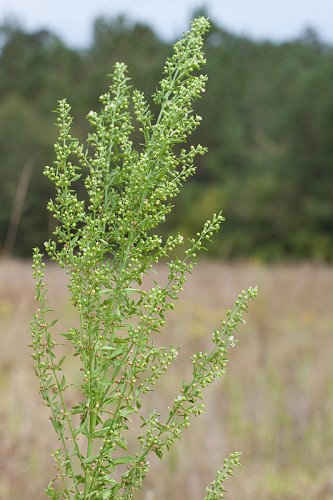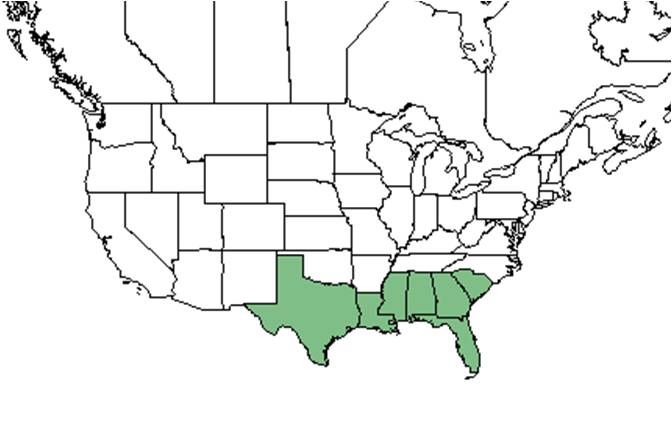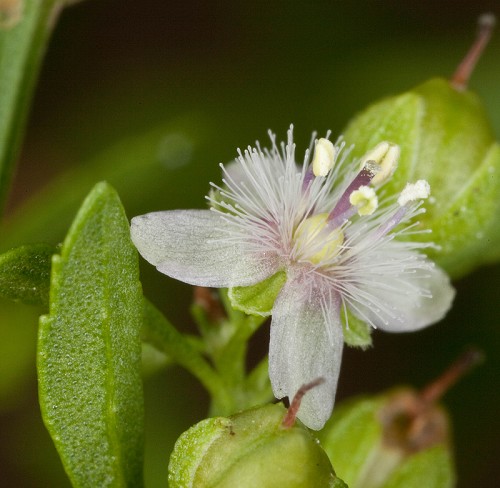Difference between revisions of "Scoparia dulcis"
(→Photo Gallery) |
(→Photo Gallery) |
||
| Line 48: | Line 48: | ||
==Photo Gallery== | ==Photo Gallery== | ||
<gallery widths=180px> | <gallery widths=180px> | ||
| − | File: Scop_dulc-JGwaltney-SEFlora.jpg | <center> Flower of | + | File: Scop_dulc-JGwaltney-SEFlora.jpg | <center> Flower of ''Scoparia'' ''dulcis'' <p> Photo by John R. Gwaltney, [http://www.southeasternflora.com/index.asp Southeastern Flora.com] </p> |
</gallery> | </gallery> | ||
Revision as of 21:23, 9 February 2016
| Scoparia dulcis | |
|---|---|

| |
| Photo by John R. Gwaltney, Southeastern Flora.com | |
| Scientific classification | |
| Kingdom: | Plantae |
| Division: | Magnoliophyta - Flowering plants |
| Class: | Magnoliopsida – Dicotyledons |
| Order: | Scrophulariales |
| Family: | Scrophulariaceae |
| Genus: | Scoparia |
| Species: | S. dulcis |
| Binomial name | |
| Scoparia dulcis L. | |

| |
| Natural range of Scoparia dulcis from USDA NRCS Plants Database. | |
Common name: Licorice weed, Sweetbroom
Contents
Taxonomic notes
Description
It is a ruderal species (FSU Herbarium).
"Erect, profusely branched perennial, 3-8 dm tall, the stems pubescent. Especially about the nodes. Leaves glandular-punctate, opposite, ovate-lanceolate to rhombic-ovate, 1-3 cm long, 6-16 mm wide, the distal ½-2/3 serrate. Flowers axillary, usually solitary, pedicel shorter than the petiole of the subtending leaf; calyx 4-parted, 1.5-2 mm long, the lobes widely ovate to elliptic, equaling or much exceeding the tube; corolla 4-parted, white, rotate, regular, the throat lanose, lobes ca. 1 mm long; stamens 4. Capsule subglobose to widely ellipsoid, ca. 2 mm long or broad." - Radford et al 1964
Distribution
Ecology
Habitat
In the Coastal Plain in Florida, S. dulcis can occur in moist loam around ponds and bordering adjacent woodlands. It has been observed in disturbed sites such as waste areas, powerlines corridors, fallow fields, and the upper edge of a restored marshy area (FSU Herbarium).
Phenology
Flowers in September and fruits in August and September (FSU Herbarium).
Seed dispersal
Seed bank and germination
Fire ecology
Pollination
The following Hymenoptera families and species were observed visiting flowers of Scoparia dulcis at Archbold Biological Station (Deyrup 2015):
Megachilidae: Megachile albitarsis
Use by animals
Diseases and parasites
Conservation and Management
Cultivation and restoration
Photo Gallery
Flower of Scoparia dulcis Photo by John R. Gwaltney, Southeastern Flora.com
References and notes
Deyrup, M.A. and N.D. 2015. Database of observations of Hymenoptera visitations to flowers of plants on Archbold Biological Station, Florida, USA.
Florida State University Robert K. Godfrey Herbarium database. URL: http://herbarium.bio.fsu.edu. Last accessed: November 2015. Collectors: Loran C. Anderson, Lisa Keppner, R. Komarek, Annie Schmidt, Cecil R. Slaughter. States and Counties: Florida: Liberty, Jefferson, St. Johns, Taylor, Washington. Compiled by Tall Timbers Research Station and Land Conservancy.
Radford, Albert E., Harry E. Ahles, and C. Ritchie Bell. Manual of the Vascular Flora of the Carolinas. 1964, 1968. The University of North Carolina Press. 937. Print.
